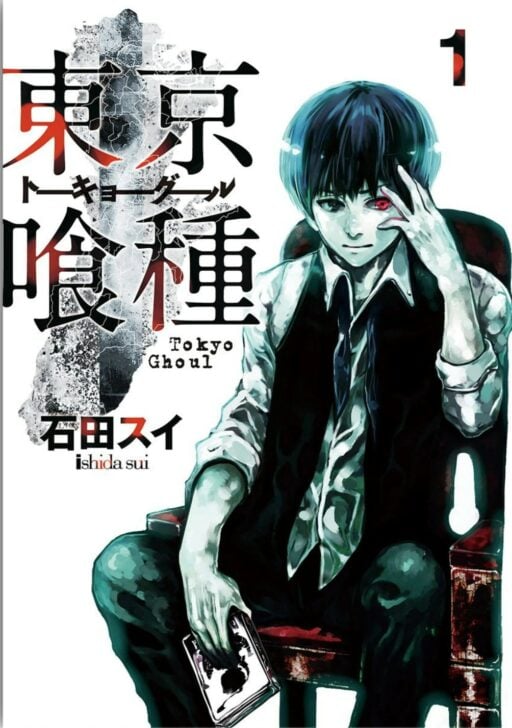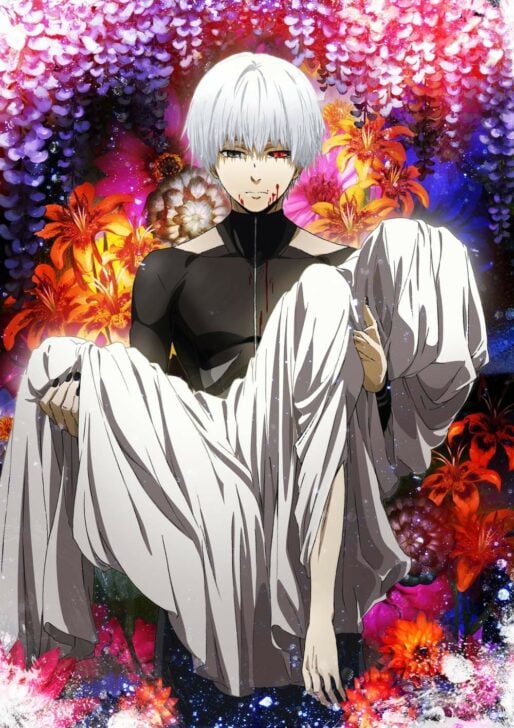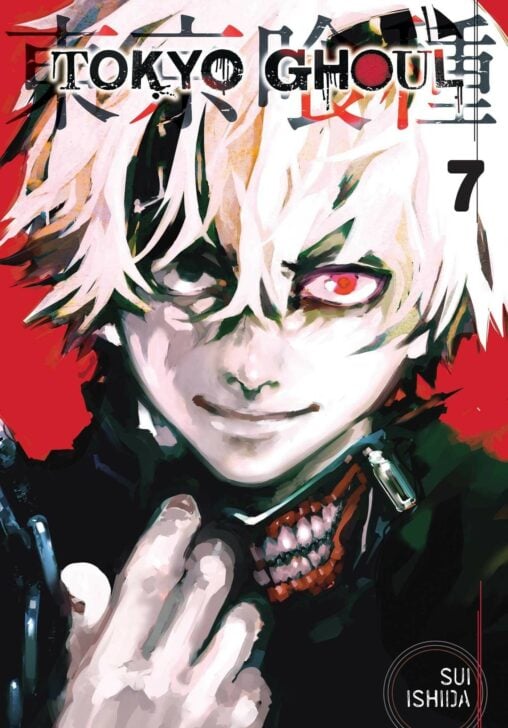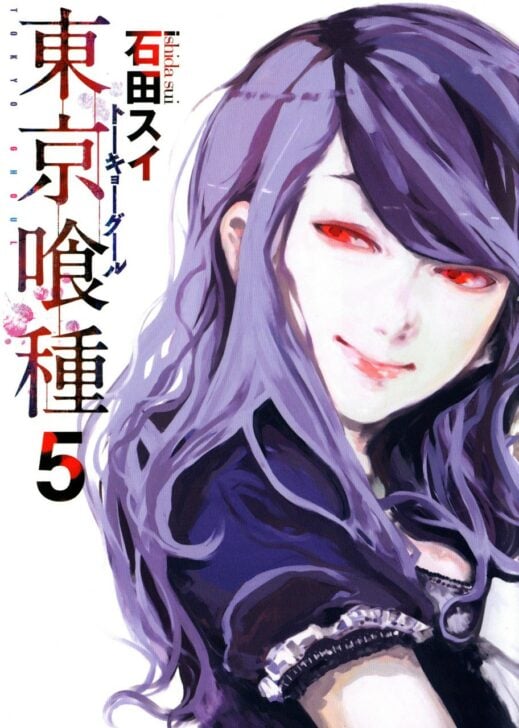Share this link via
Or copy link
Below are navigation links that will take you to the main text and navigation menus.
26,551 first names, 70,620 last names, 333,585 kanji variations.
one of the best Japanese name search tools for your baby!

Image by: Tokyo Ghoul anime season 1 official image ©Sui Ishida/Shueisha Inc・Tokyo Ghoul production committee
Contents
Tokyo Ghoul is a story written and illustrated by Sui Ishida about an ordinary human named Kaneki who turns into a ghoul. Kaneki gets involved in an accident with a ghoul named Rize. Rize dies but Kaneki gets saved by her healthy organs which transforms him into a ghoul. After Kaneki‘s tough experience he works hard to create peace between humans and ghouls.

Image by: Tokyo Ghoul comic 1 ©Sui Ishida/Shueisha Inc
The English title is exactly the same as the Japanese title ‘東京喰種’(read, Tōkyō Gūru) since it is already in English. However if you want to go into detail, Tokyo(東京) is just read as Tokyo but Ghoul(喰種) is actually written with two kanji’s which means Devour(喰, read Ku) and Species or Seed(種, read Shu or Tane.)

Image by: Tokyo Ghoul anime season 2 official image Image by: Tokyo Ghoul anime season 1 official image ©Sui Ishida/Shueisha Inc・Tokyo Ghoul production committee
This story is called ‘Tokyo Ghoul’ because it involves Ghouls, which are beings who have no choice but to feed on humans. The main characters who are also ghouls live in peace and don’t kill to eat. On the other hand, the normal ghouls kill people on a daily basis to survive. Also, the setting of this thrilling story is in Tokyo, Japan.
In Japanese culture, names have significant meanings that are supposed to represent you as a person. Names can be expressed in hiragana, katakana, and kanji. Let’s find out the meanings of some names of characters in Tokyo Ghoul.

Image by: Tokyo Ghoul comic cover 7 ©Sui Ishida/Shueisha Inc
Let’s start with the main character Kaneki(金木) Ken(研.) Kaneki is a kind and caring boy who is half-human and half-ghoul. ‘Kane’(金) means gold or money and ‘Ki’(木) means tree. Ken(研) means to hone.

Image by: Tokyo Ghoul comic cover 5 ©Sui Ishida/Shueisha Inc
Next is the ghoul who ruined Kaneki’s life, Kamishiro(神代) Rize(利世.) It all started on Kaneki’s date with Rize when she bit Kaneki revealing that she was a ghoul. ‘Kami’(神) means god and ‘Shiro’(代) means substitute. ‘Ri’(利) means benefit and ‘Ze’(世) means world. ‘Ze’(世) can also be read as ‘Se’.

Image by: Tokyo Ghoul DVD 2 cover ©Sui Ishida/Shueisha Inc・Tokyo Ghoul production committee
Let’s look into one of Kaneki’s friends, Kirishima(霧嶋) Touka(董香.) She acts seriously and always puts on a brave face but the truth is she actually really cares for her friends and has a soft side. ‘Kiri’(霧) means fog and ‘Shima’(嶋) means island. ‘Tou’(董) means to manage and the ‘Ka’(香) means fragrance.

Image by: Tokyo Ghoul Re: comic cover 4 ©Sui Ishida/Shueisha Inc
Last but not least Tsukiyama(月山) Shuu(習.) Tsukiyama is a ghoul who only feasts on the tastiest and special humans. So because Kaneki’s half-ghoul and half-human Tsukiyama is obsessed with eating Kaneki. ‘Tsuki’(月) means moon and ‘Yama’(山) means mountain. ‘Shu’(習) means to learn.
Here are some useful phrases from Tokyo Ghoul which will help you along with your Japanese studies!

Image by: Tokyo Ghoul comic 2 chapter 11 ©Sui Ishida/Shueisha Inc
You say ‘Okure mashita’(遅れました) when you are late and you say ‘Sumimasen’(スミマセン) to apologize for being so. These phrases are more commonly used at school or work.

Image by: Tokyo Ghoul comic 1 chapter 2 ©Sui Ishida/Shueisha Inc
Use this phrase to show others your resilience. Never give up and tell everyone that you will work hard by saying ‘Ganbarimasu’(がんばります!)

Image by: Tokyo Ghoul comic 2 chapter 16 ©Sui Ishida/Shueisha Inc
‘Koko’ means here. ‘Makasete’ means leave it to me but you can add ‘kudasai’ at the end to make it more polite especially when you are talking to a senior!

Image by: Tokyo Ghoul comic chapter 16
‘Kaette’ means go back. ‘Kite’ is to ask someone to come and ‘Kuru’ is coming.
Sort by Most Kanji Variations
This is the order of names with many variations of kanji.
Basically, names with more variations are more common and familiar to the Japanese.
Sort by Most Viewed
The names are sorted by the number of times they have been viewed on this site. This ranking is based on the behavior of users around the world, including Japan, so it does not mean that the names are commonly viewed by Japanese people only.
Please note that just because a name has been viewed more times does not mean it is a famous name in Japan.
What is Hiragana?
Hiragana is a syllabary used in written Japanese, which originated from the cursive style of Kanji.
What is Katakana?
Katakana is also a Japanese syllabary. Basically, the characters don't have any meaning by themselves, they only represent the sounds.
Japanese try to express the words came from foreign languages with the most similar sounds in Japanese using Katakana.
What is English Transcription?
English Transcription is a term used when translating Japanese names into English. It represents a romanised version of the name with the aim of reproducing the pronunciation as accurately as possible. English Transcription can also be used for name searches.
Japanese Style Nickname
In Japan, nicknames are commonly used to express familiarity and affection. Here are key features and contexts:
Shortened Forms: Names are often shortened for ease and intimacy, such as 'Yuki' from 'Yukiko' or 'Taka' from 'Takashi'.
Suffixes: Terms like 'chan' for girls and 'kun' for boys are added to names among close friends and family. However, 'chan' can also be used for boys during childhood. Additionally, among adults who are very close, like best friends, 'chan' may still be used to convey affection and familiarity. More Details
Usage and Cultural Aspects: Nicknames are typically used in informal settings among friends, family, or close colleagues, and are not suitable for formal or professional environments. The use of a nickname suggests a degree of intimacy and should reflect the nature of the relationship. Young people often demonstrate creativity in their social interactions by crafting unique nicknames.
Note: In Japanese, the long vowel sound is indicated by a special character called a "chōonpu" (長音符), which looks like a horizontal dash (ー). This character serves to extend the duration of the vowel sound immediately preceding it. For instance, in the name "あーちゃん" (A-chan), the "あ" (A) is extended, producing a prolonged "ah" sound, similar to the "a" in "father."
Households?
The names are sorted by the number of Japanese households where the surname is used.
The more households there are, the more famous and common the surname is.
About this site's data of last names
